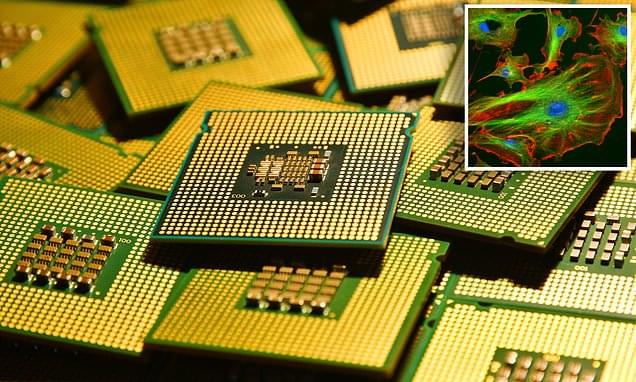Aug 31, 2023
Transistor can adhere to internal organs like tape
Posted by Shubham Ghosh Roy in categories: biotech/medical, computing
UChicago researchers’ design makes stable, suture-free medical monitoring in body possible.
UChicago researchers’ design makes stable, suture-free medical monitoring in body possible.

Future computers could be built smaller than ever before using the tiny biological skeletons that hold our cells together.
That’s according to one team of scientists, who have devised a way to make computer chips using cytoskeletons — protein scaffolds that give cells their shape.
Continue reading “Future computers could be built using proteins that make up cells” »

Subscribe here: https://goo.gl/9FS8uF
Check out the previous episode: https://www.youtube.com/watch?v=X5lpOskKF9I
Become a Patreon!: https://www.patreon.com/ColdFusion_TV
Here it is, the bio computer. A new type of parallel computing method that could rival the infamous quantum computer at a much lower price while being more practical to boot.
Continue reading “Nano-Biological Computing — Quantum Computer Alternative!” »
Quantum computers, devices that perform computations by exploiting quantum mechanical phenomena, have the potential to outperform classical computers on some tasks and optimization problems. In recent years, research teams at both academic institutions and IT companies have been trying to realize this predicted better performance for specific problems, which is broadly known as “quantum advantage.”
To reliably demonstrate that a quantum computer performs better than a classical computer, one should, among other things, collect precise measurements inside the computer and compare them to those collected in classical computers. Doing this, however, can sometimes be challenging, due to the distinct nature of these two types of devices.
Researchers at NIST/University of Maryland, UC Berkeley, Caltech and other institutes in the United States recently introduced and tested a new protocol that could help to reliably validate the advantage of quantum computers. This protocol, introduced in Nature Physics, relies on mid-circuit measurements and a cryptographic technique.

A new study exemplifies how the strides made in quantum computing are now being harnessed to unlock the secrets of fundamental science.
Scientists at Duke University have harnessed the power of quantum-based methods to unravel a puzzling phenomenon related to light-absorbing molecules, according to a new study published in Nature Chemistry.
Continue reading “Quantum simulator helps to unlock a major science mystery” »

In a bid to reduce data center power consumption, Intel has unveiled its new “Sierra Forest” chip with over double the power efficiency of other chips.
Intel has reported that its new chip, “Sierra Forest,” will have over double the efficiency for the same power consumption of other microchips. Designed as a new data center chip, Intel’s new double-efficiency chip is scheduled for release sometime in 2024, Reuters.
Continue reading “Intel makes new chip more than double the power of others” »

A team of researchers has successfully simulated and” observed” a slow-motion chemical reaction at a billion times slower than “normal.”
For the first time ever, scientists have succeeded in slowing down (in simulation) a chemical reaction by around 100 billion times. Using a quantum computer, the researchers simulated and then “observed” the reaction in super slow motion.
Continue reading “Quantum device used to slow chemical reaction 100 billion times” »
Most modern computers – from primitive room-filling behemoths like the ENIAC to the smartphone in your pocket – are built according to a set of principles laid out by the mathematician John von Neumann in 1945. This von Neumann architecture, as it is known, incorporates many familiar elements, including a central processing unit, a memory for storing data and instructions, and input and output devices. Despite its ubiquity, though, von Neumann’s model is not the only way of building a computer, and for some applications, it is not the most desirable, either.
One emerging alternative is known as neuromorphic computing. As the name implies, neuromorphic computers are inspired by the architecture of the human brain and use highly connected artificial neurons and artificial synapses to simulate the brain’s structure and functions. For researchers like Le Zhao of China’s Qilu University of Technology, this neuromorphic model offers a fantastic opportunity to develop a new paradigm for computing – as long as we can develop artificial neurons and synapses that have the right properties.
In a recent paper published in Materials Futures, Zhao and colleagues describe how to use a memristor – essentially a switch that “remembers” which electric state it was in, even after its power is turned off – to emulate the function of a synapse in the brain. Here, he explains the team’s goals and plans.
Researchers from Cornell University have identified a new state of matter in candidate topological superconductors, a discovery that may have far-reaching implications for both condensed matter physics and the fields of quantum computing.
Performing computation using quantum-mechanical phenomena such as superposition and entanglement.
“A major highlight of the work is our approach to achieve longevity: using computers to simulate the natural aging system and guide the design and rational engineering of the system to extend lifespan,” Hao told Motherboard. “This is the first time this computationally-guided engineering-based approach has been used in aging research. Our model simulations actually predicted that an oscillator can double the lifespan of the cell, but we were happily surprised that it actually did in experiments.”
The study is part of a growing corpus of mind-boggling research that may ultimately stave off some of the unpleasant byproducts of aging until later in life, while boosting life expectancy in humans overall. Though countless hurdles have to be cleared before these treatments become a reality, Hao thinks his team’s approach could eventually be applied to humans.
“I don’t see why it cannot be applied to more complex organisms,” Hao said. “If it is to be introduced to humans, then it will be a certain form of gene therapy. Of course it is still a long way ahead and the major concerns are on ethics and safety.”